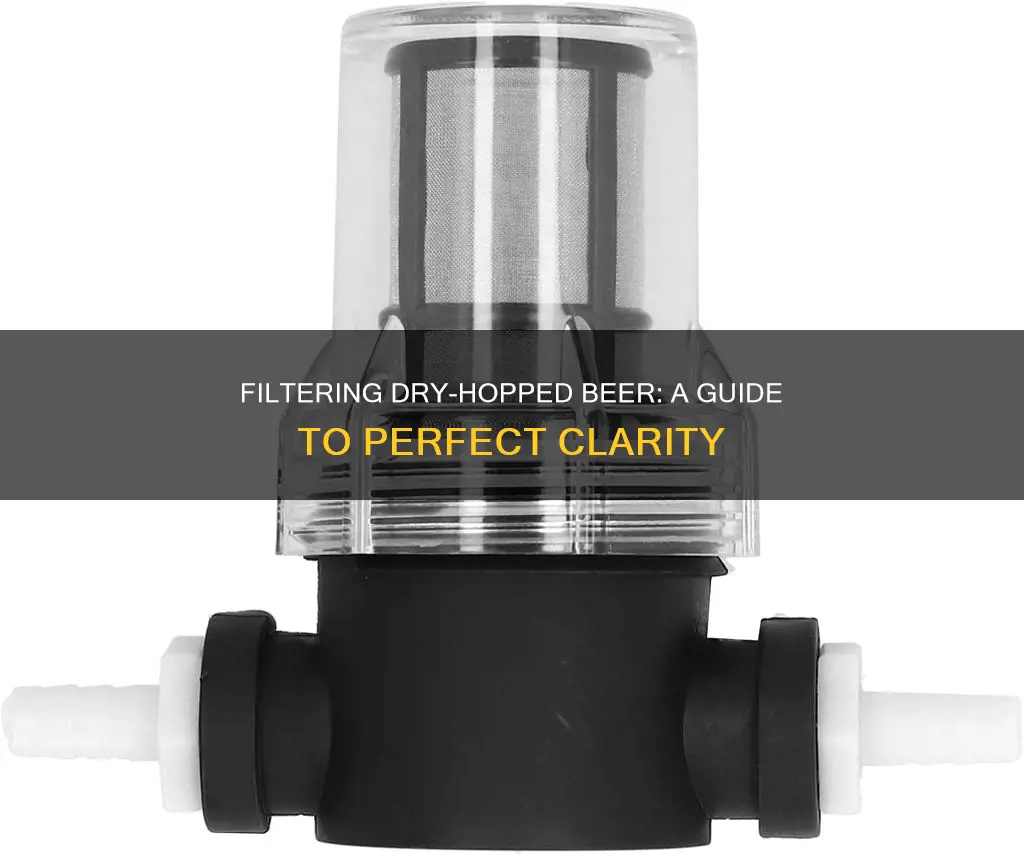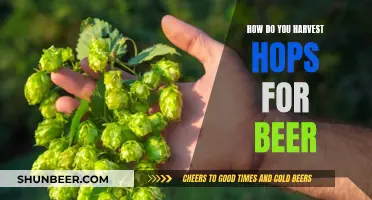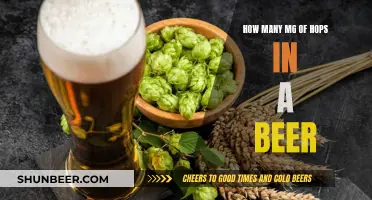
Filtering beer after dry hopping is a common practice among brewers to ensure their product is clear of any unwanted residue and has a smooth taste. While some brewers prefer to encase their hops in a filter, others opt for loose hops, which can be more convenient and allow for better beer contact. There are various methods and tools available for filtering, such as using a muslin bag, a stainless steel mesh filter, or even a paint strainer mesh. The choice of filtering method depends on the brewer's preference, the type of beer being made, and the desired level of clarity and flavour.
| Characteristics | Values |
|---|---|
| Purpose of dry hopping | To maximise hop aroma and flavour |
| When to dry hop | During or right after primary fermentation |
| Dry hopping with loose hops vs bagged hops | Loose hops are preferred as they maximise contact with the beer, but bagged hops are beneficial for reducing the risk of clogged valves and diptubes and for harvesting cleaner yeast |
| Dry hopping with pellets vs whole hops | Pellets are more convenient and readily available, but whole hops can be preferable for achieving certain flavours |
| How long to dry hop for | 3-10 days |
| Dry hopping under pressure | Can help to lock in volatile aromas and combat oxidation |
| Keg hopping | Adding hops directly to the serving keg to keep the beer's aroma fresher |
What You'll Learn

Dry hopping with loose hops vs. hops in a bag
Dry hopping is the process of adding hops to beer after primary fermentation. This can be done in the primary fermenter, in the secondary, or by adding hops directly to a keg. The benefit of dry hopping is that the brewer can get as much flavour and aroma as possible into the final beer without adding bitterness.
There are two main ways to dry hop: using loose hops or hops in a bag. Loose hops are added directly to the beer and will sink with a cold crash. Hops in a bag are contained in a mesh or muslin bag and then added to the beer.
Some brewers prefer to use a bag as it makes it easier to remove the hops from the beer. It can also help to ensure maximum volume if making smaller batches. However, others argue that letting hops roam free in the beer produces better results in terms of beer contact and overall aroma. If using a bag, a large bag is preferable as it allows the beer to flow more freely through the hops. A tight ball will decrease the overall surface area of the hops in contact with the beer. Bags can also be difficult to get in and out of carboys, which have small openings.
When using a bag, it is important to sanitise it before adding the hops, as the bag itself is not naturally resistant to bacteria. Hops in a bag also tend to float, so some brewers choose to weigh them down with something that can be sanitised, like marbles, coins, or washers. However, this can be tricky as some metals may corrode or leech into the beer.
Zywicki Portor Beer: Hops or No Hops?
You may want to see also

Filtering with muslin
Some brewers prefer to tie a sanitized muslin bag to the end of the racking cane when transferring the beer to the bottling bucket to filter out the excess hop film and floating sediment. This method is effective in keeping all the remaining floating particles from transferring to the bucket. The muslin bag idea will not affect the yeast concentration in the bottle, and the beer will carbonate just fine.
One brewer suggests using a sanitized bag with hops in it instead of putting a filter over the spigot. The movement of fluids over the trub, hops, and the mesh would possibly extract small bubbles from the beer and oxidize the product. Even if properly sanitized, it is always better to stick as little as possible into the beer.
The Art of Describing Beer Hops
You may want to see also

Pros and cons of dry hopping with pellets vs. whole hops
Dry hopping with pellets or whole hops each has its own pros and cons.
Pellets
Pellets are created by grinding up the whole hop cones and pressing them into pellets. They are the most common form of hops used in brewing, for both commercial and homebrewers. Pellets have a higher utilisation efficiency than whole hops, with a 10-15% increase in utilisation over whole hops. This means that brewers can use less of them to achieve the same level of bitterness. They are also more stable and less likely to oxidise, so they have better storage potential and a longer shelf life. They take up less space and are easier to store and measure out, and can be added to carboys during dry-hopping.
However, pellets may lose some of the delicate aromatic compounds during the pelletisation process, and they can be more difficult to remove from the wort/beer. They also tend to dissolve into a sludge, which can cause problems. If left unbagged, they will rise to the surface during the boil and won't be utilised.
Whole Hops
Whole hops are the entire hop cone, or inflorescence of a female plant. They are picked, air-dried, and pressed into bales for storage. They are the most natural, unprocessed form of hops, and some brewers think they are less harsh than pellets. They can form a filter bed when straining the boiled wort, and they are easier to remove from the beer after dry-hopping. They also retain more of their essential oils due to the fact they haven’t been processed, which can result in a greater aromatic impact.
However, whole hops take up more space and are more difficult to store and measure out. They can be difficult to get into carboys or fermenters with narrow openings, and they may require special equipment in larger brewing systems. They also absorb wort, which can result in wort loss.
Dry Hopping Tea in Beer: Enhancing Aromatics
You may want to see also

Timing of dry hopping
The timing of dry hopping is a crucial aspect of the beer-brewing process, as it can significantly impact the final product's aroma, flavour, and overall quality. Here is a detailed guide on the timing of dry hopping:
When to Dry Hop:
- The traditional approach is to add hops to the serving cask or keg shortly before serving. This method ensures the freshest aroma.
- If bottling, it is recommended to add hops to the fermenter just as fermentation starts to slow down. This is usually apparent by the diminishing kraeusen (foamy head) and decreased bubbling in the airlock, typically 3-4 days after fermentation begins.
- For dry hopping in the primary fermenter, it is crucial to wait until the start of fermentation or close to it. Hops are not sterile, so adding them too early can lead to contamination.
- The ideal time to dry hop is when the beer's pH has dropped, creating an unfavourable environment for organisms on the hops to survive. Additionally, the presence of alcohol and a healthy yeast population also help suppress bacterial growth.
- Dry hopping should be done after the initial vigorous CO2 generation phase during primary fermentation. This way, the CO2 won't scrub the hop aroma from the beer.
Factors Affecting Dry Hop Timing:
- Beer Style: The timing of dry hopping can vary depending on the style of beer being brewed. For example, IPAs and pale ales are commonly associated with dry hopping.
- Desired Aroma and Flavour: The length of dry hopping influences the intensity of the hop aroma and flavour. A shorter duration may result in a more pungent and resinous character, while a longer duration can lead to a cleaner, juice-like flavour.
- Type of Hops: The type of hops used, such as pellets, whole hops, or plugs, can impact the timing. Pellet hops release their extract faster, usually within a day or two, while whole hops can take a week or more.
- Temperature: Temperature plays a role in the quality and strength of the hop aroma. Warmer temperatures tend to extract more oils, and a rule of thumb for fermenter dry hopping is around 70 °F (21 °C).
- Form of Hops: The physical form of the hops, such as pellets, plugs, or loose hops, can affect the timing and ease of use. Plugs, for example, are specifically designed for dry hopping and are easy to measure and fit through carboy necks.
- Personal Preference: Ultimately, the timing of dry hopping depends on personal preference and the desired intensity of hop aroma and flavour in the final beer. Experimentation is key to finding the ideal timing for your brew.
Hops' Role in Extending Beer's Shelf Life and Stability
You may want to see also

Dry hopping under pressure
One key advantage is the ability to ferment at higher temperatures, which can speed up the fermentation process. Pressure fermentation also allows for natural carbonation of the beer inside the vessel, eliminating the need for additional carbonation steps.
Another benefit of dry hopping under pressure is the reduction of esters and fusel flavors in the beer. This is due to the decreased yeast and ester production rates under higher pressure conditions. Additionally, the closed system of pressure fermentation minimizes the risk of oxidation, as oxygen is not able to interact with the fermenting yeast.
When dry hopping under pressure, it is important to consider the potential challenges. For example, higher pressures can reduce yeast cell division, affecting the fermentation process. It is also crucial to carefully manage the addition of dry hops to avoid a "dry hop volcano," where the hops provide more nucleation points in the naturally carbonated beer.
To dry hop under pressure, brewers can utilize a keg or a specialized pressurized conical fermenter like the FermZilla or Fermentasaurus. When using a keg, it is recommended to use a hop sock or tea strainer to contain the hops and prevent clogging of dip tubes or taps. The hops can be hung using string or allowed to sink to the bottom with sanitized marbles.
Overall, dry hopping under pressure can be a valuable technique for brewers looking to enhance the aroma and flavor of their beers while also streamlining the fermentation process and minimizing oxidation.
Hops' Role in Brewing: Aromatic and Bitter Beer Balancing
You may want to see also
Frequently asked questions
You can tie a piece of muslin bag or paint strainer mesh over the inside opening of the spigot. Alternatively, you can use a sanitized bag to dry hop, and then use gelatin to clear the beer.
You can use both pellet and whole leaf hops for dry hopping. Pellet hops are more convenient and readily available, while leaf hops take up more space in the fermenter and soak up more beer, decreasing the overall yield. Commercial breweries tend to use pellets because they have a longer shelf life and are more efficient.
Your beer’s flavor profile and characteristics should dictate which types of hops you use. There aren’t necessarily any wrong hops to choose from, but you should stick with aroma-forward hops. Popular choices include Cascade, Centennial, Amarillo, Simcoe, Citra, Mosaic, and Galaxy.
This depends on the style of beer you are brewing and the desired level of aroma. For a typical American or West Coast-style IPA, dry hopping for 2-4 days is sufficient. For New England-style IPAs, dry hopping can be done during active fermentation (days 0-5) or after terminal gravity has been reached (days 5-8).







